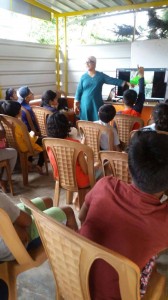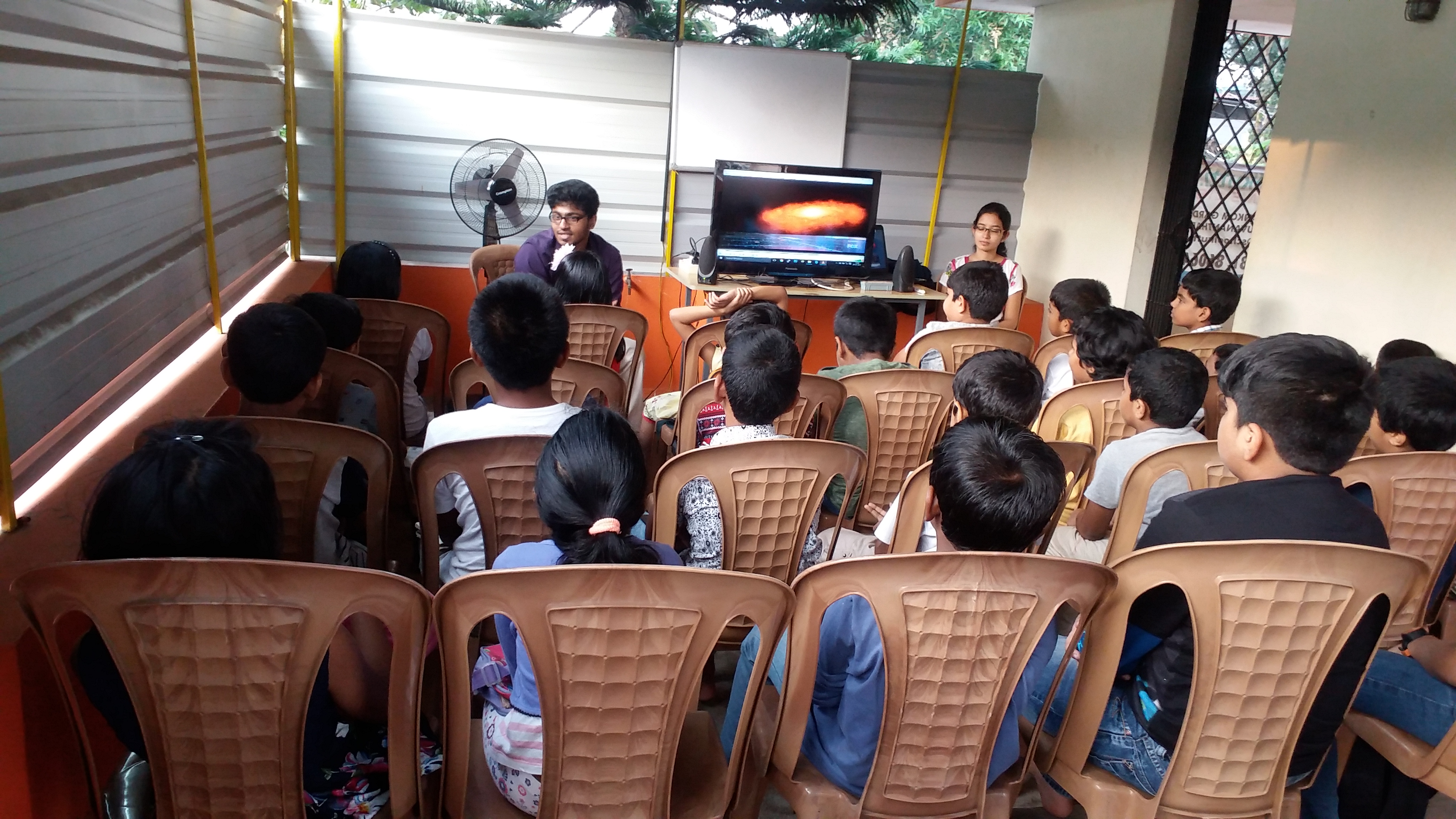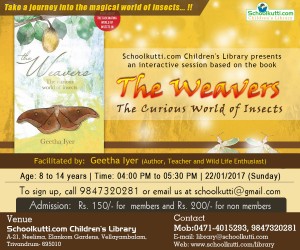Monthly Archives: January 2017
Celestial Wonders – Session 4
Today’s was the last session of the Astronomy Workshop ‘Celestial Wonders’ by Aswin Jacob at Schoolkutti.com Children’s Library. Children were full of excitement and eager to learn something new.
Rainbow Colors
Aswin started with a discussion about how the white color is composed of many constituent colors and about the experiment that is done using the Newton’s disc. After that, he spoke about how a camera works. Then the children had great fun trying to build a pinhole camera.
Telescopes as Time Machines
It was good to know the the story behind the invention of telescope, the inventors and about the different components of telescope. Children also learned about the purpose of the hubble space telescope, how it works and why it is superior to the normal telescopes on earth.
This series of Astronomy Workshops was a unique learning experience for the children.
Weavers – Workshop on Insects
Did you think that spiders are insects? No, neither are millipedes and centipedes. What happens when a wasp attacks a cockroach? It was interesting to know that the venom attacks the neurotransmitters of the cockroach that blocks its escape response. The stung cockroach is not only paralyzed,its motivation to run also is gone. The wasp drags the cockroach and lays eggs on it so that the larvae can feed on it later.
What should you do to reduce the chances of getting stung by a wasp? Hold still with your eyes closed. Rapid movement startles the insect and encourages stinging.
Belgica antarctica, the Antarctic midge, is a species of flightless midge, endemic to the continent of Antarctica. At 2–6 mm (0.079–0.24 in) long, it is the largest purely terrestrial animal on the continent, as well as its only insect.
Children learned all this and much more in the Weavers – The Curious World of Insects Workshop – at Schoolkutti.com Children’s Library on 22nd January, 2017. Geetha Iyer, Biologist, Education Consultant and Author brought together little-known aspects of insect life.

Kids had fun trying to identify and learning about the various insects in the photographs that were displayed.
Celestial Wonders – Session 2
Today’s topic in the ‘Celestial Wonders’ program was ‘Discovering the Milky Way’. Here is a quick look at few of the discussions we had.
How can we see the milky way if we are inside it? Isn’t it like trying to take a picture of the outside of your house while being IN your house? Because we are inside the Milky Way, we don’t get to take any pictures of it from an angle above it, but we only get pictures in which we see the structure of the Milky Way edge-on, from inside of it.
Exactly how far is an object when we say that an object is light years away? What do we understand when we look at objects that are light years away through a telescope? It was interesting to learn that the distance to Proxima Centauri is only four light years. However, it takes the light from our stellar next door neighbor four years to get to Earth.
We talked about dwarf galaxies, which are small galaxies composed of about 100 million up to several billion stars, a small number compared to the Milky Way’s 200–400 billion stars. Our milky way is expected to now grow mainly by eating smaller galaxies, rather than by collecting gas.
It was quite interesting to find out how the radiation from the sun reaches the earth. The magnetic field around earth protects our body’s DNA from being affected by this radiation. A very small change in our DNA can even affect the way we look.
Children were also curious to know how the planets, moons and asteroids in the Solar System were formed. After debating over some interesting theories and watching informative videos, we came to the end of the session.
The Weavers – The Curious World of Insects
Did you know…
– Dance flies of the family Empididae have been courting their mates for eons by presenting them with silk-wrapped prey as nuptial gifts.
– There are at least twenty-three different categories of silk, each the result of natural selection and an independent evolutionary pathway.
– Some moth-caterpillars will walk only on a path of silk, leaving human monarchy a tad inferior surely.
– Silk is an excellent material for select surgical procedures.
Schoolkutti.com Children’s Library is conducting an interactive session based on the book ‘The Weavers – The Curious World of Insects’ by Prof. Geetha Iyer (Author, Teacher and Wild Life Enthusiast) for children of age 8 to 14 years on January 22nd Sunday. Since life evolved on this planet, there have been six major extinctions and insects – since their arrival 400 million years ago – have been amongst them! How did they survive when species after species went extinct? In a world that is fast collapsing to global warming and climate change, there is now an increased interest in knowing the secrets of insect survival. With silken thread forming the central motif, The Weavers brings together little-known aspects of insect life.
Geetha Iyer is an ardent wildlife watcher, naturalist, author, teacher, and consultant in the twin fields of education and environment. A Zoology graduate with a Ph.D. in Education from Madras University, she has several years of experience in the area of designing and executing science and environment education curriculum. She enjoys writing about bringing biodiversity into the classroom and regularly conducts workshops about the environment, education and natural history.
Venue: Schoolkutti.com Children’s Library, Trivandrum
Dates: Jan 22 (Sunday)
Time: 4 to 5:30 PM
Fee: Rs. 150/- for members and Rs.200/- for non members
Call 9847320281 or 4015293 for more information.
Click here to register
http://schoolkutti.com/events/schoolkutti-events-details.php?id=110&districtId=1
Celestial Wonders – Session 1
What are the rings around the planet Saturn? What causes the fire inside the belly of Sun? What is spectroscopy? What are the different elements that are required for life to sustain on a planet? Why is Mars called the Red Planet? All these interesting questions were answered by Aswin Jacobs in the introductory session of Astronomy Workshop, which started at Schoolkutti.com Children’s Library today. Children were excited to learn that fire in the sun is not caused by burning like we see on earth, but due to the various nuclear reactions.

Today’s topic was ‘Lift off into Space’. Children tried to imagine how fast they would need to throw an object in such a way that the object does not return and remains in the outer space. All of them remembered what happens if they let the air out of a balloon – the air goes one way and the balloon moves in the opposite direction. Aswin explained that rockets work in pretty much the same way. Exhaust gases coming out of the engine nozzle at high speed push the rocket forward. Children enjoyed watching the accompanying videos.
Kids loved learning a wide range of fun facts about space and astronomy. They were not afraid to ask questions at any point and the session was quite successful in stimulating their curiosity and in expanding their cosmic perspective.





